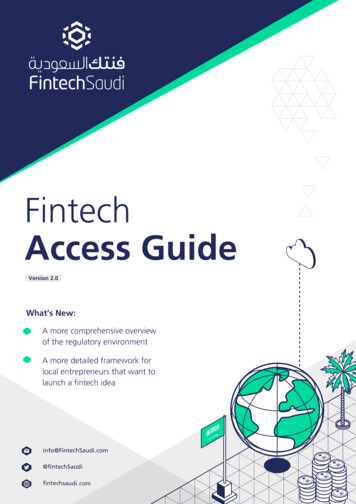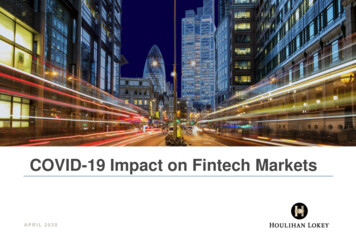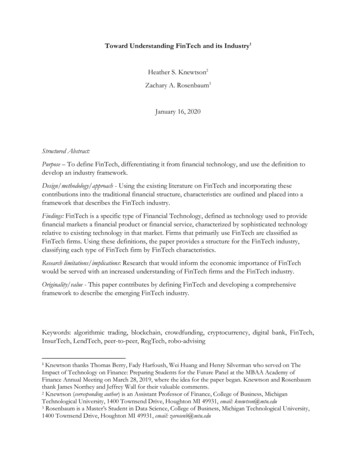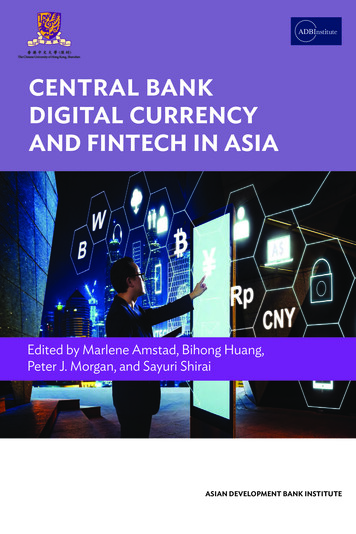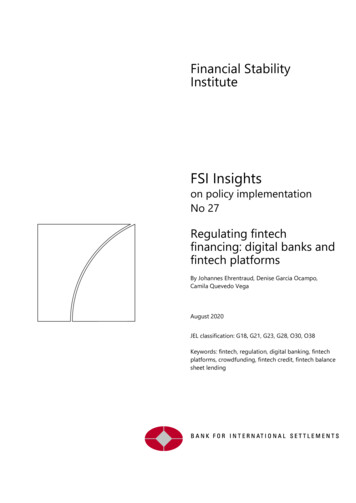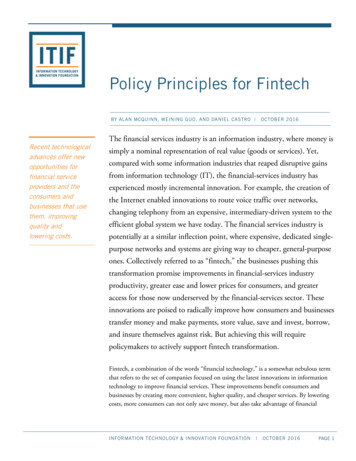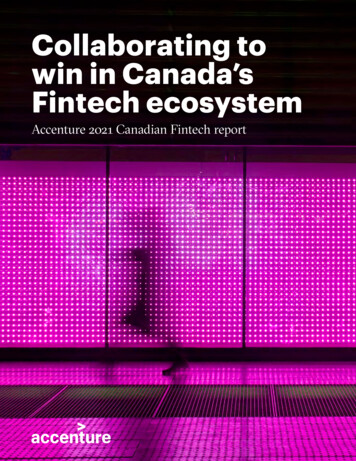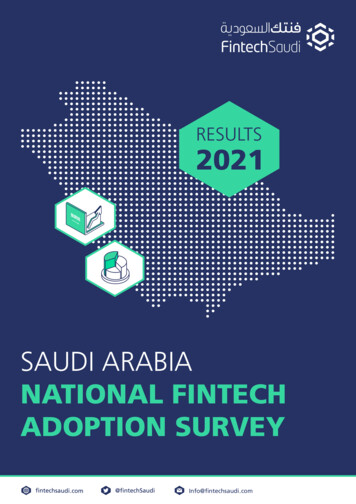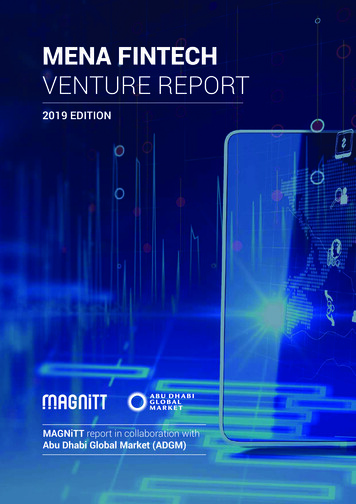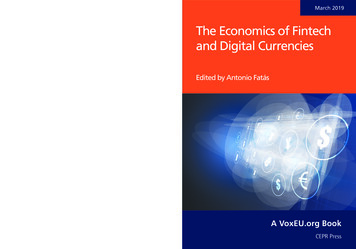
Transcription
March 2019 Technology and governance. Can these new technologies becompatible with the strict requirements of financial markets? Candecentralised systems replace the traditional financial market that relieson intermediaries and a central authority? The economics of blockchain. Is blockchain technology and itsdecentralised consensus mechanism viable in financial markets? Private and public digital currencies. Can private digital currenciessuch as Bitcoin compete with traditional currencies? Do digital currencies(including those issued by a central bank) make the financial system morerobust and efficient? Regulation of cryptocurrencies and ICOs. How should regulationapproach new assets such as cryptocurrencies and initial coin offerings(ICOs)? Should we ignore them or regulate them like traditional securities,or do we need new rules to deal with their digital nature?ISBN 978-1-912179-18-3Centre for Economic Policy Research33 Great Sutton StreetLondon EC1V 0DXTel: 44 (0)20 7183 8801Email: cepr@cepr.org www.cepr.orgCEPR Press9 781912 179183The Economics of Fintech and Digital CurrenciesThe explosion of cryptocurrencies such as Bitcoin, as well as an array of newtechnologies in financial markets (fintech), has attracted the interest ofinvestors, financial institutions, the media as well as policymakers. The promiseof radical changes has been met with excitement but also a good dose ofscepticism. This eBook brings together eleven contributions from membersof CEPR’s Research and Policy Network on Fintech and Digital Currencies onsome of the key areas where these changes are becoming more visible. Thebook covers four main topics.The Economics of Fintechand Digital CurrenciesEdited by Antonio FatásA VoxEU.org BookCEPR Press
The Economics of Fintechand Digital Currencies
CEPR PressCentre for Economic Policy Research33 Great Sutton StreetLondon, EC1V 0DXUKTel: 44 (0)20 7183 8801Email: cepr@cepr.orgWeb: www.cepr.orgISBN: 978-1-912179-18-3Copyright CEPR Press, 2019.
The Economics of Fintechand Digital CurrenciesEdited by Antonio FatasA VoxEU.org eBookCEPR Press
Centre for Economic Policy Research (CEPR)The Centre for Economic Policy Research (CEPR) is a network of over 1,200 researcheconomists based mostly in European universities. The Centre’s goal is twofold: topromote world-class research, and to get the policy-relevant results into the hands ofkey decision-makers.CEPR’s guiding principle is ‘Research excellence with policy relevance’.A registered charity since it was founded in 1983, CEPR is independent of all publicand private interest groups. It takes no institutional stand on economic policy mattersand its core funding comes from its Institutional Members and sales of publications.Because it draws on such a large network of researchers, its output reflects a broadspectrum of individual viewpoints as well as perspectives drawn from civil society.CEPR research may include views on policy, but the Trustees of the Centre do not giveprior review to its publications. The opinions expressed in this report are those of theauthors and not those of CEPR.Chair of the BoardFounder and Honorary PresidentPresidentVice PresidentsVoxEU Editor-in-ChiefChief Executive OfficerSir Charlie BeanRichard PortesBeatrice Weder di MauroMaristella BotticiniUgo PanizzaHélène ReyRichard BaldwinTessa Ogden
ContentsForewordIntroductionAntonio Fatásvii1Part 1: Technology and governance1Finance and blockchainStephen G. Cecchetti and Kermit L. Schoenholtz2Distributed ledger technologies and start-up financingKatrin Tinn3Blockchain technology and government applications:A proposal for a Global Patent OfficeEdgardo Di Nicola Carena, Pierfrancesco La Mura,and Alessandro Rebucci71521Part 2: The economics of cryptocurrencies4Some simple Bitcoin economicsLinda Schilling and Harald Uhlig315The doomsday economics of ‘proof-of-work’ in cryptocurrenciesRaphael A. Auer39Part 3: Private and public digital money6Digital money: Private versus publicMarkus Brunnermeier and Dirk Niepelt497Central bank digital currencies and private banksDavid Andolfatto578Stablecoins: The quest for a low-volatility cryptocurrencyAleksander Berentsen and Fabian Schär65
Part 4: Cryptocurrencies, ICOs, and regulation9Initial coin offerings: Fundamentally different but highlycorrelatedAntonio Fatás and Beatrice Weder di Mauro7510 Cryptocurrencies: Why not (to) regulate?Raphael Auer and Stijn Claessens8311 Regulating fintech: Ignore, duck type, or codeMarlene Amstad91
ForewordIn late 2018 CEPR established a new type of research network – a Research and PolicyNetwork (RPN) – with the main aims of building a community of researchers around aparticular topic and ensuring that policy issues are considered over a longer time periodthan is often the case when a single piece of output is produced and the researchersinvolved then move on. An RPN consists of 15-30 experts, many of whom are CEPRResearch Fellows or Affiliates, with an interest in a topic of high policy relevance andwhere academic research and collaboration with policymakers can have a high impact.The RPN on Fintech and Digital Currencies, established on 1 September 2018 foran initial three-year term, is led by Professor Antonio Fatás (INSEAD and CEPR),the editor of this eBook. The main goal of the network is to generate, coordinateand disseminate academic research related to the broad issue of the potential of newtechnologies to change the way financial markets operate or institutions compete. Thenature of the topics means that the network brings together a community of researchersfrom different fields of economics (finance, macroeconomics, industrial organisation).In addition, it seeks to foster a dialogue among academics and policymakers (centralbankers and regulators) about the optimal policies to deal with these changes in financialmarkets.This is the first of what we hope will be a series of eBooks emanating from CEPR’sResearch and Policy Network on Fintech and Digital Currencies. It brings together a setof eleven contributions from members of the network on some of the key areas wherechanges are becoming more visible. The chapters cover four main topics: Technology and governance. Can these new technologies be compatible with thestrict requirements of financial markets? Can decentralised systems replace the traditional financial market with its reliance on intermediaries and a central authority? The economics of blockchain. Is blockchain technology and its decentralised consensus mechanism viable in financial markets?vii
The Economics of Fintech and Digital Currencies Private and public digital currencies. Can private digital currencies such as Bitcoin compete with traditional currencies? Do digital currencies (including thoseissued by a central bank) make the financial system more robust and efficient? Regulation of cryptocurrencies and initial coin offerings (ICOs). How shouldregulation approach new assets such as cryptocurrencies and ICOs? Should we ignore them or regulate them like traditional securities, or do we need new rules todeal with their digital nature?CEPR thanks Antonio Fatás for his editorship of this eBook, Anil Shamdasani andSophie Roughton for their work on its production, and Kirsty McNeill for her effortsin administering the network’s activities. CEPR, which takes no institutional positionson economic policy matters, is glad to provide a platform for an exchange of views onthis topic.Tessa OgdenChief Executive Officer, CEPRMarch 2019viii
IntroductionAntonio FatásINSEAD and CEPRIn recent years, financial markets have seen the arrival of new technologies, openinga debate about the extent of their consequences. Are we about to witness significantdisruptions to the nature of money, for example, or the way new ventures are funded?The potential for radical changes has been met with both excitement and a gooddose of scepticism. And the rapid increase and sudden crash in the prices of majorcryptocurrencies over the last two years has been a wake-up call to how optimisticviews of the disruptive possibilities of these new technologies can disappoint. But, atthe same time, while the Bitcoin price remains far from its record levels, there aremany areas where progress is being made and new technologies are still receiving theattention of aspiring entrepreneurs and established financial institutions, as well ascentral banks and regulators.In September 2018, CEPR launched a new Policy and Research Network on “Fintechand Digital Currencies” to foster a dialogue between researchers and policymakers onall issues related to technology and financial markets (‘fintech’). This eBook bringstogether eleven chapters from members of the network on the current state of thedebate. It summarises current research on the impact of these changes as well as theviews of policymakers on how to manage the possible disruption in financial markets.Technology and governanceThe first three chapters deal with both the new possibilities created by the technologiesas well as the potential limits to their adoption. The chapters stress the need for someform of centralised authority to manage the requirements in financial markets. Chapter1, by Stephen Cecchetti and Kim Schoenholtz, focuses on the changes taking placein the technology used to maintain financial records. Different technologies have1
The Economics of Fintech and Digital Currenciesdifferent implications for governance and access rights. Both of these issues make itpractically impossible to imagine the widespread adoption of open-access ledgers (suchas blockchain) in financial markets.Chapter 2, by Katrin Tinn, discusses the benefits of the adoption of hash-linkedtimestamping technology in financial contracts. While the benefits are clear, the chapteralso raises questions about the governance of these technologies and suggests thatpermissioned systems might be the right way to move forward.Chapter 3, by Edgardo Di Nicola Carena, Pierfrancesco La Mura and AlessandroRebucci, analyses one particular application of timestamping technology, namely, thecreation of a global patent office. In this case, transparency and the ability to reach aglobal community represent significant benefits. But, as in the previous two chapters, theauthors also stress the need to rely on a central authority for the purpose of governance.The economics of cryptocurrenciesChapter 4, by Harald Uhlig and Linda Schilling, analyses the equilibrium price of acryptocurrency under the assumption that it succeeds in the future and co-exists with atraditional currency (such as the US dollar). The analysis shows why speculation in theperiods before adoption might not be possible in equilibrium. In addition, the authorsexplore the monetary policy implications of the future existence of such an alternativecurrency.Chapter 5, by Raphael Auer, presents a pessimistic view of the viability ofcryptocurrencies. In particular, the author highlights that the proof-of-work technologybehind cryptocurrencies such as Bitcoin is subject to an externality similar to thetragedy of the commons. As a result, the income necessary to ensure a well-functioningconsensus mechanism will fall short and liquidity will shrink. The author then discussespossible changes to the available technology that could address this imperfection.2
IntroductionAntonio FatásPrivate and public digital moneyThe next three chapters delve into the question of how new technologies are changingthe way we think about money and the potential competition between private andpublic (digital) money. Chapter 6, by Markus Brunnemeier and Dirk Niepelt, startswith a typology of different forms of money and then discusses the consequences ofintroducing digital central bank currency (CBDC). Under some assumptions, there isan equivalence between private and public money and, as a result, introducing centralbank digital currencies would not have macroeconomic effects.Chapter 7, by David Andolfatto, also analyses the introduction of CBDC but in adifferent setting. The objective here is to understand the effects that the introduction ofCBDC might have on lending as well as the stability of the financial system. The modelsketched in the chapter dismisses some of the common criticisms of CBDC by showingthat it would have no negative consequences on lending and it would not increase theinstability of the financial system.Chapter 8, by Aleksander Berentsen and Fabian Schär, discusses ‘stablecoins’ –cryptocurrencies whose price is kept fixed in units of a traditional currency. Severalalternatives that have been proposed and the authors suggest that the on-chain, fullycollateralised option may be the best available, although it is still a work in progressbecause of the inherent risks in the technology being used.Cryptocurrencies, ICOs, and regulationOne of the recent innovations in financial markets is the new funding model behindinitial coin offerings (ICOs). Chapter 9, by Antonio Fatas and Beatrice Weder di Mauro,discusses some of the potential benefits and risks of ICOs. The evidence is mixed – themarket has grown very fast but the high failure rate of ICOs, combined with abundantexamples of fraudulent schemes, raises serious concerns about the long-term viabilityof this market. In addition, empirical analysis shows a very high correlation of ICOreturns with Bitcoin or Ethereum prices, suggesting that the bubble-type behaviour ofthose cryptocurrencies was behind the hype of ICOs.3
The Economics of Fintech and Digital CurrenciesThe final two chapters look at the challenges that these innovations pose to regulators.Chapter 10, by Raphael Auer and Stijn Claessens, discusses the benefits and costsof regulating cryptocurrencies. Empirical analysis shows that news about regulationaffect the prices of these assets, signalling that national regulators do have some power.But regulating cryptocurrencies could imply giving credibility to these new assets.The alternative – i.e. ‘benign neglect’ – is not optimal either because of the negativeconsequences of an unregulated market that funds illegal activities or tax fraud. Apotential solution is to enforce a minimum amount of regulation along the lines of antimoney laundering activities.In a related analysis, Chapter 11, by Marlene Amstad, presents the different approachesthat regulators around the world have followed when it comes to fintech innovations.The two most common approaches are ignoring them (i.e. leaving them unregulated) ortreating them like other traditional securities. The author suggests a third alternative thattakes into account the special nature of these new technologies and designs regulationthat is tailored to their specific features.What next?The chapters in this eBook have addressed several of the most pressing issues in the debate overwhat to expect from, and what to do about, new technologies in financial markets. The hype andthen crash in the Bitcoin price offers an illustration of how some of the early excitement mighthave been premature. The various contributors to the book have identified changes that could helpthese technologies move forward to become viable in an environment – financial markets – wheregovernance and regulation are central. The reality is that efforts to incorporate new technologiesin financial markets have not slowed down; if anything, they have accelerated and are likely tolead to new innovations that might address some of the early weaknesses. The academic researchbehind this book remains a work in progress and should, over time, help policymakers design anoptimal response to changes in the technology environment of financial markets.4
Part 1Technology and governance5
1 Finance and blockchainStephen G. Cecchetti and Kermit L. Schoenholtz1Brandeis International Business School and CEPR; NYU Stern School of Busines“Only 1% of 3,138 chief information officers at companies surveyed by Gartnerlast year said they had ‘any kind of blockchain adoption’ .”The Wall Street Journal, 7 May 2018.Blockchain is all the rage. We are constantly bombarded by reports of how it willchange the world. While it may alter many aspects of our lives, our suspicion is thatthey will be in areas that we experience only indirectly. That is, blockchain technologymostly will change the implementation of invisible processes – what businesses thinkof as their back-office functions.In this chapter, we briefly describe blockchain technology, the problem it is designed tosolve, and the impact it might have on finance.Blockchain basicsBlockchain is a record-keeping mechanism; a 21st century version of the recordingsystems that have been around since people started chiselling marks on cave walls.Over the millennia we have moved from ledgers that are carved into clay and stone toones that are digital.To be more specific, consider the problem of tracking the ownership of a share ofequity. Imagine that there is a sequential list of all owners, with the name of each1We thank Morten Bech, Ethan Cecchetti, and Hanna Halaburda for patiently explaining many aspects of how theblockchain works and how its applications to economics and finance. An earlier version of this chapter appeared onwww.moneyandbanking.com.7
The Economics of Fintech and Digital Currenciescrossed out, except for that of the current owner. The key question is the following: whohas the right to cross out a name and write in a new one?Put another way, the challenge we face is to create a tamper-proof and universallyaccepted way of recording things like ownership of assets, obligations of one person toprovide a product or service to another, levels of inventories, personal identities, andthe like. What we require is that the system be a reliable, secure, and trusted mechanismfor accessing and updating essential records that cannot be hijacked by someone withill intent.The four types of ledgersIn thinking about the challenge of maintaining records – a ledger – consider differencesalong two dimensions: the structure of the database in which the records are stored, andhow we establish that any changes are legitimate. Along the first dimension – ledgerstructure and ownership – the database and its ownership can be either centralised ordistributed. And, on the second dimension – access rights – the system can have limitedaccess in which a restricted number of people (or entities) can make alterations, oropen and public access (also called ‘permissionless’) so that anyone can participate. Ineither case, following a legitimate modification, all versions are immediately updated,guaranteeing agreement on the current state.This two-by-two classification system leads to four ledger frameworks. To understandthis taxonomy, Tables 1 and 2 provide a set of nonfinancial and financial examples.2The upper-left cell of each table is the case of a centralised database with limited,proprietary access rights. This case captures the ledger practices of human civilisationuntil now. There is one central ledger containing the authoritative record of ownership orobligations that can only be changed by the organisation or person maintaining it. Whilethere may be copies, there is only one definitive version. Examples are everywhere –hospital records and records of securities ownership are just two.28For a more detailed discussion with examples, see Haeringer and Halaburda (2018) and Dwyer (2016).
Finance and blockchainStephen G. Cecchetti and Kermit L. SchoenholtzTable 1Ledger structure and ownership, and access rights: Nonfinancial examplesLedger structureand ownershipAccess ital records(current systems)Customer ratings(user review websites)DistributedSupply chain inventory*(closed, trusted networks)Property title*(proof of work/stakesystems)Note: *Potential implementations.Table 2Ledger structure and ownership, and access rights: Financial examplesLedger structureand ownershipAccess rities ownershiprecords(current systems)CFPB ConsumerComplaint Database(user review websites)DistributedCLSnet(closed, trusted networks)Bitcoin(proof of work)Note: CFPB is the Consumer Financial Protection Bureau.Turning to the top-right cell, this is the case of an open-access, but centralised recordingsystem that allows anyone to write and read. Lacking security, this mechanism is oflimited use. Nevertheless, examples exist. In the nonfinancial realm, these includethe customer rating systems employed by Amazon, eBay, TripAdvisor and the like.Wikipedia uses this protocol for creating and updating entries. Given the securityconcerns, financial examples are more difficult to find. One instance is the ConsumerComplaint Database of the Consumer Financial Protection Bureau (CFPB).The bottom rows cover the range of distributed (or decentralised) databases. Thedistinction here is that there are now many copies of the ledger, all with equal standing.So long as they follow an agreed set of rules, anyone who has a copy can make a9
The Economics of Fintech and Digital Currencieschange. Put another way, participants directly interact with each other. And, as with thecentralised systems, there are two cases: limited access and permissionless.Blockchain technology seeks to implement distributed systems, providing automaticmechanisms that create trust, ensuring there are no conflicting changes, and preventingmalicious actors from making unauthorised or improper changes. It has the potentialto record transactions between two parties, maintaining an agreed sequence, withoutreliance on potentially costly third-party verification.To prevent people from arbitrarily attacking the system, violating trust, and makingillegitimate modifications, the ability to alter the ledger is based on a scarce resource.In the limited-access model, the scarce resource is identity – only specific people orinstitutions can make modifications. The idea of an open system is to make identityirrelevant – anyone can join, leave, and re-join as often as desired. Here the scarceresource that allows alterations to the ledger can be something like computationalpower or a stake (possibly financial) in the system.In the open system, participants can make changes so long as they follow the rules.Importantly, the rules must prevent a bad actor from capturing the system. The originalBitcoin protocol, where the scarce resource is computational power, is immune fromtakeover so long as no one controls more than half of the computing power. But, as hasbeen pointed out repeatedly, the system is incredibly expensive, generating substantialdeadweight loss. Electricity costs alone exceed 3 billion per year.The uncertain future of blockchainBoth financial and nonfinancial uses of blockchains remain limited, with the obviousexceptions of cryptocurrencies. In Table 1, we list two possible nonfinancial applications– supply chain inventory management and property title records – but so far as weknow, neither has yet been implemented on a broad scale.Where is this all heading? Without a further theoretical breakthrough, open distributedsystems appear both costly and slow. Estimates for the Bitcoin protocol, for example,are that speeds cannot exceed seven transactions per second. In contrast, there may besome promise in distributed systems that are proprietary. We suspect that most of the10
Finance and blockchainStephen G. Cecchetti and Kermit L. Schoenholtzcorporate developers working on such projects have this kind of architecture in mind,perhaps in the hopes of creating a profitable monopoly. Unfortunately, a monopolistwould be unlikely to lower transactions costs in the way that the advocates of opendistributed systems hope.Conceivably, a blockchain system could securely track the ownership of every financialinstrument and exposure in the global economy. While this is a very tall order, it wouldbe truly revolutionary. Financial market participants could overcome informationasymmetries, improving risk pricing and capital allocation. Authorities could monitorposition concentrations and other risks to the financial system. And, money launderingand terrorist finance would be easier to police.In practice, we are still a long way off. Before we can map the entirety of the financialsystem, we need to be able to identify both entities and instruments globally.3 But evenif such identifiers are in place, we question whether people would be happy with theresult. It would create a world without privacy in which everyone’s balance sheet andtransactions are public. Even if a much less invasive version were to become possible, itwould be deeply ironic if blockchain, a technology initially championed by libertariansdisenchanted by government and fiat money, ended up by narrowing the range ofindividual freedoms.Today, blockchain faces a major problem of scalability. The fastest proprietaryblockchain systems currently can handle no more than several thousand transactionsper second.4 To put this into perspective, at its peak the Depository Trust & ClearingCorporation (DTCC) processes 25,000 equity transactions per second (roughly thesame as VISA’s payments processing capacity). DTCC (2018) points out that any newtechnology would have to have a maximum capacity of 2 to 3 times this peak – more3For a discussion of global legal entity identifiers (LEIs) and global financial instrument identifiers (FIIs), see Cecchettiand Schoenholtz (2017b).4Since all copies of a distributed ledger must be revised before anyone can record the next transaction, the speed of lightmaterially limits the rate at which these systems can operate. If, for example, there a ledger is in both New York andLondon, at a minimum, it will take between 20 to 40 milliseconds for a transaction in one location to be recorded in theother. This means that fully distributed systems cannot process more than 50 transactions per second. Some degree ofcentralisation, combined with geographic proximity, lowers this latency and increases the maximum throughput.11
The Economics of Fintech and Digital Currenciesthan 50,000 equity transactions per second. For the foreseeable future, given physicalconstraints on the speed of transmission for such a large volume of information, wesee no way that the financial system can escape its reliance on centralised clearing andsettlement systems.5ConclusionAll that said, we really have little idea where this will lead. A decade since the appearanceof Nakamoto’s (2008) paper that launched Bitcoin, we have more than 1,000 cryptoclones. But where are the broader applications of the blockchain technology? Weexpect that it will find increased use in the clearing, payments, and settlement system(Cecchetti and Schoenholtz 2017a). Perhaps it also will be applied across a range of otheractivities, such as recording property titles or managing the supply chain both withinand across firms or for a variety of accounting and audit functions. Such applicationswould likely focus on cases with limited numbers of transactions and where speed isless important. But, for now, we anticipate the development and implementation ofproprietary systems, not those with open access.ReferencesBank for International Settlements (BIS) (2018), “Cryptocurrencies: looking beyondthe hype“, Annual Economic Report, June.Budish, E (2018), “The Economic Limits of Bitcoin and the Blockchain“,NBERWorking Paper No. 24717.Cecchetti, S G and K L Schoenholtz (2017a), “Modernizing the U.S. Payments System:Faster, Cheaper, and More Secure“, www.moneyandbanking.com, 31 July.5Permissionless distributed systems of the type use for Bitcoin also face a severe incentive problem. As Chapter V of themost recent BIS Annual Economic Report (BIS 2018) describes in detail, the possibility that the system will be takenover means that it is impossible to guarantee finality. Budish (2018) derives the condition under which Bitcoin-stylesystems will be attacked and captured by a malicious actor.12
Finance and blockchainStephen G. Cecchetti and Kermit L. SchoenholtzCecchetti, S G and K L Schoenholtz (2017b), “Managing Risk and Complexity: LegalEntity Identifier“, www.moneyandbanking.com, 30 October.Depository Trust and Clearing Corporation (DTCC) (2018), “Modernizing the U.S.Equity Markets Post-Trade Infrastructure“, January.Dwyer, G P (2016), “Blockchain: A Primer“, MPRA Paper 76562, University Libraryof Munich.Haeringer, G and H Halaburda (2018), “Bitcoin: A Revolution?”, Baruch CollegeZicklin School of Business Research Paper No. 2018-05-01.Nakamoto, S (2018), “Bitcoin: A Peer-to-Peer Electronic Cash System”.About the authorsStephen G. Cecchetti is the Rosen Family Chair in International Finance at the BrandeisInternational Business School. Before rejoining Brandeis in 2014, he completed a fiveyear term as Economic Adviser and Head of the Monetary and Economic Department atthe Bank for International Settlements. During his time at the BIS, Cecchetti participatedin the numerous post-crisis global regulatory reform initiatives. In addition to his otherappointments, Cecchetti served as Director of Research at the Federal Reserve Bankof New York; Editor of the Journal of Money, Credit, and Banking; and is currentlyResearch Associate of National Bureau of Economic Research and Research Fellow ofthe Centre for Economic Policy Research since 2008. Cecchetti has published widelyin academic and policy journals, and is the author of a leading textbook in money andbanking. Together with Kim Schoenholtz, he blogs at www.moneyandbanking.com.Kim Schoenholtz is the Henry Kaufman Professor of the History of Financial Institutionsand Markets in the Economics Department of NYU Stern School of Business. He alsodirects the Stern Center for Global Economy and Business. Previously, Schoenholtzwas Citigroup’s Global Chief Economist from 1997 until 2005. Schoenholtz currentlyserves on the Financial Research Advisory Committee
The RPN on Fintech and Digital Currencies, established on 1 September 2018 for an initial three-year term, is led by Professor Antonio Fatás (INSEAD and CEPR), the editor of this eBook. The main goal of the network is to generate, coordinate and disseminate academic re

